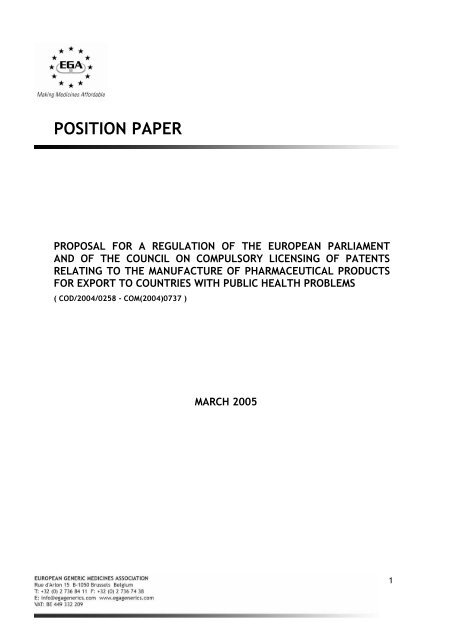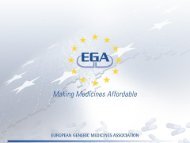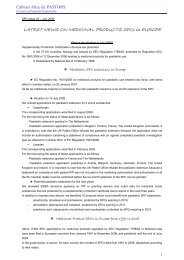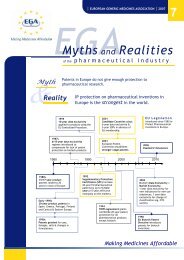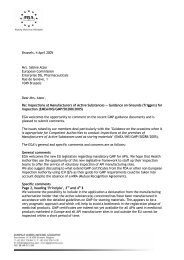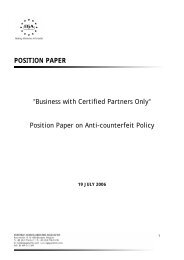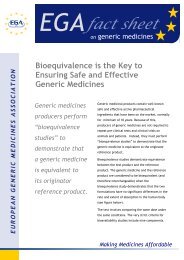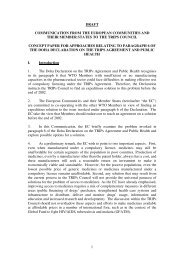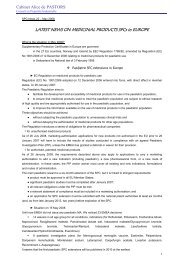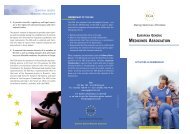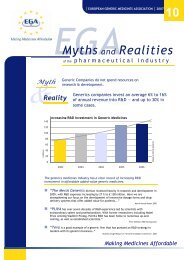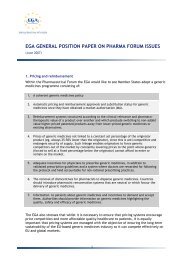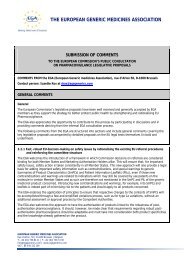EGA Position Paper - European Generic medicines Association
EGA Position Paper - European Generic medicines Association
EGA Position Paper - European Generic medicines Association
Create successful ePaper yourself
Turn your PDF publications into a flip-book with our unique Google optimized e-Paper software.
POSITION PAPERPROPOSAL FOR A REGULATION OF THE EUROPEAN PARLIAMENTAND OF THE COUNCIL ON COMPULSORY LICENSING OF PATENTSRELATING TO THE MANUFACTURE OF PHARMACEUTICAL PRODUCTSFOR EXPORT TO COUNTRIES WITH PUBLIC HEALTH PROBLEMS( COD/2004/0258 - COM(2004)0737 )MARCH 20051
<strong>EGA</strong> POSITION PAPER: FINAL DRAFTPROPOSAL FOR A REGULATION OF THE EUROPEAN PARLIAMENT AND OF THE COUNCILON COMPULSORY LICENSING OF PATENTS RELATING TO THE MANUFACTURE OFPHARMACEUTICAL PRODUCTS FOR EXPORT TO COUNTRIES WITH PUBLIC HEALTHPROBLEMS (COD/2004/0258 - COM(2004)0737 )The <strong>EGA</strong> welcomes the <strong>European</strong> Commission’s initiative to propose a Regulation aimed atimplementing the Decision of the WTO General Council of 30 August 2003 to allowcountries with insufficient or no manufacturing capacities to make effective use ofcompulsory licensing.However, it must be stressed that — in both the Decision and the draft Regulation — theprocedures are complicated, the terms under which new producers must operate are veryrestrictive, and the various measures proposed are ambiguous. For these reasons, it isimportant that adoption of the Regulation does not draw attention away from otherinitiatives, such as EU and global funding for essential <strong>medicines</strong>, which are aimed atimproving access to <strong>medicines</strong> in other countries.Similarly, greater attention should be given to preventing the inclusion of TRIPs PLUSrequirements into bilateral trade agreements between members of the WTO that have anegative impact on the supply of generic <strong>medicines</strong> in countries with health needs.1. <strong>EGA</strong> welcomes the following positive aspects of the Regulation:• Exclusion of a list of restrained products.• Exclusion of a list of restrained diseases.• Exclusion of a ‘right of first refusal’ provision 1 (misleadingly termed “Equal Opportunityto supply countries in need”)• Inclusion of a provision 2 allowing derogation of Data Exclusivity: no requirement toprovide results of pre clinical and clinical trials. Possibility of obtaining the MarketingAuthorisation immediately rather than having to wait 8 years.• Inclusion of a provision 3 allowing derogation of the Sunset Clause: in case a MarketingAuthorisation exists, it will not expire after 3 years without marketing the product.• Exclusion of a ‘Too commercial in nature’ clause 4 .1 This provision gives the patent holder the right to assume contracts negotiated between generic producersand purchasers in the importing countries. The effect is that it blocks a Compulsory License for a generic.2 Article 16 of the proposed Regulation3 Article 16 of the proposed Regulation which derogates Article 14(4) and (5) of Regulation (EC) no. 726/20044 The patent owner can challenge in court a generic company contract if the selling price in the contract ishigher than 25% of the brand name price -and consequently have CL revoked-.2
2. The <strong>EGA</strong> is concerned about the following aspects of the Regulation2.1 Healthcare Perspective2.1.2 All countries in need should be covered by the provisionAs the draft EC Regulation is limited to members of the WTO, more than 40 Least-Developed Countries (non-WTO members) are automatically excluded and will not benefitfrom the compulsory licensing system, as presented in the Commission’s proposal. Thesecountries are continuously confronted with public health problems (i.e. HIV, TB andmalaria).Furthermore, Canada and Norway, which were the first countries to implement the WTOGeneral Council Decision, do not restrict the list of countries in need only to WTOmembers.2.1.3 The buyer should not be restricted to a foreign government or its agent.NGOs delivering frontline healthcare services in developing countries with health problemsshould be have access to the <strong>medicines</strong> to assure their correct distribution.2.1.4 There are no incentives or funding mechanisms for cases in which<strong>medicines</strong> are still too expensive for the poorest countries.Under the proposed Regulation, <strong>European</strong> companies will only be able to supply these<strong>medicines</strong> to Least Developed Countries or countries with non-existent or insufficientmanufacturing capacities. These countries often have limited ability to pay for even thelowest cost <strong>medicines</strong> available. Solvable demand needs to be guaranteed for producers.Moreover, a new producer must start from zero research, manufacturing and developingfor each product provided. These companies cannot finance this development andproduction by means of sales on <strong>European</strong> or US markets as is the case for companiesselling the patented <strong>medicines</strong>. In this context it will be important to see what incentivesor guaranteed purchase funding can be provided (either through Community funding ornational foreign aid policies) to help companies produce and sell these specially required<strong>medicines</strong>.3
2.2 Practical use of the system.The procedure to issue a compulsory license should be quick and easy, rather thandiscretionary and complex.2.2.1 Article 5.3(c) Identification of patent(s) and SPC(s) in the applicationThe patent-holder can patent several molecules (different salts, esters, ethers, isomers,mixtures of isomers, complexes or derivatives of an active substance) along with theirmanufacturing process. The identification of all patents and SPCs by the applicant wouldbe extremely difficult and constraining. Therefore the applicant should only be required toidentify the product which, by extension, would cover all patents related to the product.(It should be noted that the identification of patents subject to a compulsory license is notrequired by the WTO Decision).2.2.2 Article 5.3(g) TenderingThis article implies that the producer can only respond to a specific request from a WTOmember. It seems to exclude the possibility of using a compulsory license in the case ofinternational tendering to purchase <strong>medicines</strong>. The relationship between the tenderingprocedure and the procedure for obtaining a compulsory license is extremely unclear andshould be clarified, as the tendering procedure will be by far the preferred method ofmanufacturing and supplying <strong>medicines</strong> to countries in needs.2.2.3 Article 5.4. Additional formal and administrative requirementsSupplementary requirements on the applicant could discourage an application for acompulsory licence or result in an increase in the cost of the medicine concerned. Thisarticle should be deleted.2.2.4 Article 6.2. Volume restriction in compulsory license issued in an EUMember StateThe requirement in Article 6.2 ensuring that the combined volume of product from eachcompulsory license issued within the EU must not exceed the total volume requested bythe importing country is impractical and unworkable for the following reasons:! There is no reporting mechanism in EU Member States to track the issuance ofcompulsory licenses.! Restricting the volume in each compulsory license before knowing which companywill in fact win/respond to an EU global tender would result in restrictions ofsupply, particularly where one or more of the companies receiving a compulsorylicense failed to win or respond to tender.! In any event, the purpose of the article to restrict volume cannot be enforced as itdoes not take into account the issuance of compulsory licenses in WTO countriesoutside the EU.This requirement should therefore be dropped and replaced by a simple statement that‘the CL is issued to meet the requirements of the importing countries until these needs are4
met’. Failure to make this change will render it virtually impossible for ‘competing’companies to operate in the CL/tender market.2.2.5 Article 7. Promotion of voluntary agreements. Requirement to obtainauthorization from right holder.Article 7 imposes the obligation on the applicant to provide evidence that efforts havebeen made to obtain authorisation from the right holder on reasonable terms andconditions, and that such efforts have not been successful within a reasonable period oftime.However, Article 31 (b) of the TRIPS Agreement allows this requirement to be waived inthe following situations: national emergency, extreme urgency, public non-commercial useor where the CL is issued to remedy an anticompetitive practice. Article 7 is therefore toorestrictive as it merely orders that these situations be taken into account whendetermining ‘a reasonable period of time’ for obtaining the voluntary license. It appearsthat the applicant would have to try to obtain a voluntary license even in cases where theWTO member has declared a situation of national emergency. Such an approach will createuncertainty and delay. In conclusion, the prior negotiation requirement imposed by article7 should be waived where the importing country indicates one of the circumstances listedin article 31 (b) of TRIPs.Moreover, Article 7 needs clarification. As currently worded, it creates legal uncertainty inthe context of an export procedure that is meant to be as simple and least burdensome aspossible. It provides no clear definition of how long a new producer must attempt tonegotiate a voluntary license. A fixed period of 30 days must be set for these negotiations,as otherwise they could drag on endlessly, delaying — or even stalling permanently — thedelivery of <strong>medicines</strong>.2.2.6 Article 8.3 Rights conferredThis article limits the scope of the license “strictly to acts of manufacturing and selling forexport”. In line with the WTO Decision — which is much broader in this aspect — theimportation of APIs (active pharmaceutical ingredients) to produce the pharmaceuticalproducts requested should specifically be permitted.2.2.7 Article 8.9. Royalties concerning compulsory licensingArticle 8.9 also needs to be clarified as the term “adequate remuneration” is too vague.Certainty must exist on the royalties to be paid when a Compulsory License is granted.Otherwise, the generic producer would be placed in the impossible position of beingexpected to enter into export agreements before knowing the royalty rate, the duration ofthe agreement, the quantity permitted by the CL, or even whether the CL was obtainableat all.A more suitable approach would be to calculate the royalty on the basis of the UN’s HumanDevelopment Index (HDI) rank. Under this approach, the maximum royalty payable would5
e a maximum 4% of the total value of the product exported under the license. This is theformula adopted under Canadian legislation.2.2.8 Article 10. Evaluation timeA set period for evaluating an application should be established for the entire EU in orderto harmonize the maximum time of proceeding with compulsory licensing in all MemberStates. To make short work of products with no delay, the maximum duration of evaluationshould be short and well defined. This would provide an approximation of the first deliverydate to the countries in need, taking into account the time for R&D, manufacture, anddelivery of products. The CL could be granted within, for example, 30 days from the dateof application.2.2.9 Article 15. Appeal and interlocutory injunctionsThis article permits an “appeal against any decision of the competent authority”.Because of Article 15, the patentee could readily obtain a frivolous injunction blockingdelivery of the <strong>medicines</strong>. This type of measure serves to create a high level of uncertaintyfor new producers. It should be made clear that an appeal by the patentee will notautomatically suspend the execution of the compulsory license.2.2.10 Article 16. Derogation of Data exclusivity.It is assumed that the provisions in Articles 16.1 and 16.3 derogate the data exclusivityprovision (formula 8+2+1) provided for in Article 10(1) of Directive 2001/83/EC. Thederogation of data exclusivity should be expressed more clearly.2.2.11 Article 12. Re-importation issueArticle 12 contains provisions for the “detention and disposal” of a product when a reasonexists “to suspect re-importation”. Certain safeguard measures should be established toavoid anticompetitive strategies such as false allegations of re-importation designed toblock the generic producer. However, <strong>EGA</strong> recognises the need to set up controlmechanisms to avoid re-importation.2.2.12 Guarantee for new producer to supply product free from competitionfrom the originatorOnce a compulsory license has been granted, guarantees should be given that the newproducer(s) will be able to supply the product free of competition from the originators.Otherwise, the new producers will be reluctant to undertake the necessary investment ifthis can subsequently be undermined by a supply of the patented product.6


